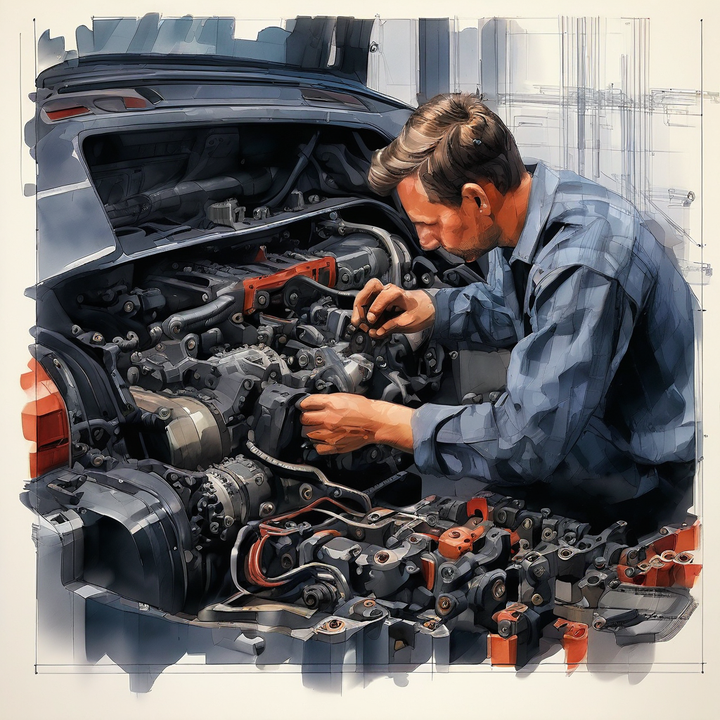


The Diagnostic Trouble Code (DTC) P03EE refers to an issue with the "A" Camshaft Profile Actuator "C" Control Circuit High in Bank 1. This code is part of the OBD-II system used in vehicles to monitor and report issues related to the engine and other critical systems. Understanding the specifics of this code can help in diagnosing and resolving the underlying problem effectively.
Before we dive into the nitty-gritty details, let's break down the code itself. The P03EE is an OBD-II (On-Board Diagnostics) code, which is part of a standardized system designed to monitor and report on various vehicle components and systems. This code specifically relates to the camshaft profile actuator, a crucial component responsible for adjusting the camshaft profile to optimize engine performance and efficiency.
| Code Component | Explanation |
|---|---|
| P03EE | OBD-II code |
| A | Specific camshaft profile actuator circuit |
| C | Control circuit |
| High Bank 1 | Issue occurring in the first cylinder bank |
The "A" in the code refers to the specific camshaft profile actuator circuit, while "C" indicates that it's related to the control circuit. "High Bank 1" signifies that the issue is occurring in the first cylinder bank, which is typically the side of the engine where the number one cylinder is located.
Now, let's explore the potential culprits behind this code. One of the most common causes is wiring issues. Over time, wiring harnesses can become damaged, connections can loosen, or pins can corrode, leading to disruptions in the camshaft profile actuator circuit.
Damaged wiring
Loose connections
Corroded pins
Another potential cause is a faulty camshaft profile actuator itself. These actuators can become stuck, clogged, or simply malfunction, resulting in a high circuit voltage that triggers the P03EE code.
Additionally, issues with the engine control module (ECM) can also be responsible for this code. The ECM is the brain of the engine management system, and any software glitches or internal circuit problems can cause it to misinterpret or mishandle the camshaft profile actuator signals.
As a mechanic, I always emphasize the importance of a thorough diagnostic process. When faced with the P03EE code, the first step is to visually inspect the wiring harness, connectors, and the actuator itself for any signs of damage, corrosion, or loose connections.
| Inspection Point | Potential Issues |
|---|---|
| Wiring harness | Damage, cuts, fraying |
| Connectors | Corrosion, loose fit |
| Actuator | Stuck, clogged, damaged |
It's also crucial to check for any technical service bulletins (TSBs) related to this code for your specific vehicle make, model, and year, as manufacturers often provide valuable insights and updates.
Next, I recommend using a digital multimeter to check the voltage supply to the actuator circuit. Any deviations from the specified values can indicate a problem. Additionally, performing a resistance test on the actuator itself can help identify any internal faults or stuck components.
If the wiring and actuator check out, it's time to turn our attention to the ECM. Check for any available software updates or reprogramming options that may address the P03EE issue.
Once the root cause has been identified, it's time to roll up our sleeves and get to work. If wiring issues are the culprit, repairing or replacing any damaged wiring, cleaning corroded connectors, and ensuring all connections are secure should resolve the problem.
Repair or replace damaged wiring
Clean corroded connectors
Secure loose connections
If the camshaft profile actuator is found to be defective, it will need to be replaced with a new one, following the manufacturer's instructions to the letter. This process can be intricate, as the actuator is often integrated into the engine's valve train system, requiring careful disassembly and reassembly.
In cases where the ECM is the source of the issue, reprogramming or replacing it may be necessary. This is typically a more complex and costly repair, but it's essential to ensure the proper functioning of the engine management system.
As the saying goes, "an ounce of prevention is worth a pound of cure." To minimize the likelihood of encountering the P03EE code again, I strongly recommend following a few preventive measures.
First and foremost, regular maintenance is key. Adhering to the recommended service intervals for engine oil changes and other maintenance tasks can go a long way in keeping your vehicle's components in top shape.
| Maintenance Task | Frequency |
|---|---|
| Engine oil change | As recommended by manufacturer |
| Air filter replacement | As recommended by manufacturer |
| Spark plug replacement | As recommended by manufacturer |
Secondly, proper usage is crucial. Avoid excessive idling or high-load conditions that can accelerate wear on the camshaft components. Treat your vehicle with care, and it will reward you with reliable performance.
Lastly, periodic inspections of the wiring harness and connectors can help catch any potential issues before they escalate. A little vigilance can save you from costly repairs down the line.
Now, let's address the elephant in the room – the cost of repairs. The expenses can vary depending on the specific cause and the labor rates in your area.
| Repair Type | Approximate Cost Range |
|---|---|
| Wiring repair | $100 - $300 (parts and labor) |
| Camshaft profile actuator replacement | $200 - $500 (parts and labor) |
| ECM reprogramming or replacement | $300 - $1,000 (parts and labor) |
It's important to note that these are just estimates, and the actual cost may vary based on your vehicle's make, model, and the complexity of the repair. My advice? Always seek a quote from a qualified mechanic or dealership to get an accurate estimate for your specific situation.
Dealing with the P03EE code can be a daunting task, but with the right knowledge and approach, it's a challenge that can be overcome. As a mechanic, I've seen my fair share of these codes, and I can assure you that a methodical diagnostic process, coupled with proper repair techniques, can resolve even the most stubborn issues.
Remember, preventive maintenance and responsible vehicle usage are your best allies in avoiding costly repairs down the line. So, treat your ride with the care it deserves, and it will reward you with reliable performance for years to come.
Happy motoring, my friends! And if you ever find yourself facing the P03EE code, don't hesitate to reach out to a trusted mechanic for guidance. Together, we can conquer any automotive challenge that comes our way.
The P03EE is an OBD-II diagnostic trouble code that indicates an issue with the "A" camshaft profile actuator control circuit high in the first cylinder bank (Bank 1) of the engine.
The most common causes include wiring issues (damaged wiring, loose connections, corroded pins), a faulty camshaft profile actuator (stuck, clogged, or malfunctioning), and problems with the engine control module (ECM) software or internal circuits.
Visually inspect the wiring harness, connectors, and actuator for any signs of damage or corrosion. Check for technical service bulletins, use a multimeter to test the voltage and resistance, and check for ECM software updates or reprogramming options.
Repair or replace any damaged wiring, clean corroded connectors, and secure loose connections. If the actuator is faulty, replace it following the manufacturer's instructions. If the ECM is the issue, reprogram or replace it as needed.
Follow the recommended maintenance schedule for oil changes and other services. Avoid excessive idling or high-load conditions. Inspect the wiring harness and connectors periodically for any signs of damage or corrosion.
Wiring repair: $100 - $300 (parts and labor), Camshaft profile actuator replacement: $200 - $500 (parts and labor), ECM reprogramming or replacement: $300 - $1,000 (parts and labor).
The camshaft profile actuator is a component responsible for adjusting the camshaft profile to optimize engine performance and efficiency. It plays a crucial role in the engine's valve train system.
"Bank 1" refers to the first cylinder bank, which is typically the side of the engine where the number one cylinder is located.
Yes, issues with the engine control module (ECM), such as software glitches or internal circuit problems, can cause the ECM to misinterpret or mishandle the camshaft profile actuator signals, triggering the P03EE code.
Checking for TSBs related to the P03EE code for your specific vehicle make, model, and year is crucial because manufacturers often provide valuable insights, updates, and recommendations to address known issues.

Miguel started tinkering with car radios as a teenager, fascinated by the intricate dance of wires and circuits. This passion led him to pursue a career as an automotive electrician. For the past 10 years, Miguel has tackled everything from flickering headlights to mysterious electrical gremlins. He thrives on troubleshooting electrical problems and enjoys sharing his knowledge to empower car owners to understand their vehicles better.



